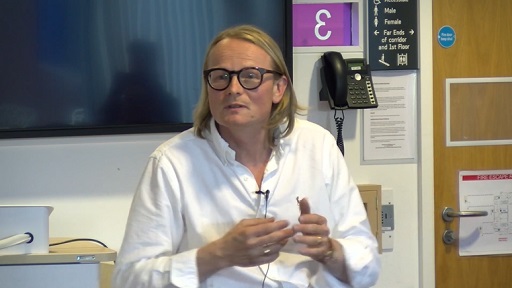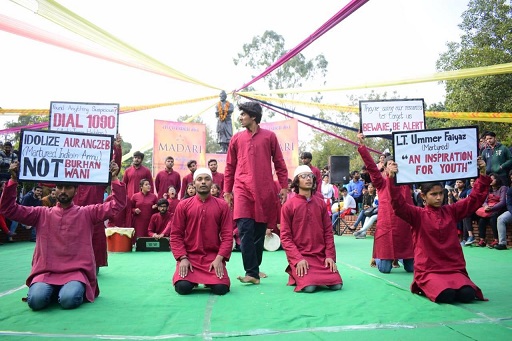Use 'Print preview' to check the number of pages and printer settings.
Print functionality varies between browsers.
Printable page generated Thursday, 25 April 2024, 12:38 AM
6 Embodiment
Introduction
In this section we will consider the relationship between embodiment and empowerment in research. Think about how you see your own body when you are doing research. Do you see it as an intrusion or a potential source of disruption?
Empowering methodologies begin with an acknowledgment of the importance of bodies – both human and non-human – as a necessary precondition of embedded knowledge and understanding. Here we will consider the role of the body in the research process and the importance of embodiment in empowering organisational research.
We use our bodies all the time when doing research. Yet there is relatively little acknowledgement of the importance of researchers’ bodies in accounts of the research process, even when the researcher is working closely with organisations and individuals over a long time period. Nor is there much consideration of the researcher’s body in related practices, including reading, thinking, writing and talking.
The reasons for this relate to a way of thinking developed from within a Eurocentric philosophical tradition that has become globally dominant (Connell, 2007). The artificial separation of mind from body is associated with René Descartes, whose philosophical ideas established the foundations for a mind/body dualism that ‘constructs the body as fundamentally different from and subservient to the soul, mind and consciousness’ at a time when modern Western thought was beginning to take shape (Thanem and Knights, 2019: 21). This dualism informs how we think about and treat bodies in social and organisational research – including researchers’ bodies (see Film Focus 11).
Conventional methodological advice tends to position the researcher’s body as peripheral or problematic in the production of knowledge. Consequently, researchers are advised to try to minimise the effects of their physical presence in any social setting they are researching. The reasons for this relate to the perceived importance of the
However, it is impossible to remove the body from research settings; qualitative researchers in particular have sought to acknowledge its presence and potential. Interviewer(s) and interviewee(s) understood each other not just verbally but also by reading each other’s body language, or observing how each other respond to questions and answers. The interpretive method of
While methods like participant observation involve watching the bodies of others as they act, perform and interact, there is a danger here of objectification. The term ‘scopophilia’ refers to the pleasure of looking: ‘taking other people as objects and subjecting them to a controlling and curious gaze’ (Mulvey, 2009: 17). While this term originates in Mulvey’s analysis of cinematic representations of women as passive objects of a ‘male gaze’, related concepts exist in postcolonial theory, where the gaze is used to understand how colonial and imperialist powers seek to dominate and discipline colonial subjects. As introduced in Section 3, the ‘white gaze’ positions the colonised subject as the ‘Other’ who is called upon to mimic Western cultural values, norms and institutions – even though this always involves failure, because they are ‘almost the same but not quite’ (Bhabha, 1994: 84, emphasis in original). Extending the concept of the gaze into organisational research enables us to appreciate how bodies are conventionally treated and to propose more empowering alternatives. Specifically, it encourages us to think about bodies relationally, through our own encounters, and to turn the gaze on ourselves.
There is a further difficulty in conventional understandings of embodiment enabled by methods like participant observation. This arises because they position the body as an instrument that can be used to collect data using sight; meaning that the other senses that the body uses to encounter and learn about the world (including touch, smell, hearing and taste) tend to be overlooked or treated as secondary. This
Embodied research involves more than simply using the body as a research tool. Instead it implies a challenge to how we understand knowledge and knowing (see Section 5). The importance of embodiment in empowering research arises from alternative ways of knowing that are opened up by taking the body seriously as a source of understanding and a medium for communicating knowledge. Empowering research explicitly draws attention to the presence of bodies in research settings and focuses on actions, performances and encounters between them. The body, including the researchers’ own body, is thereby understood as a site of research: the focus of a deliberate attentiveness through which understandings of power relations, and the bodily discipline that they produce, may be gained.
Yet it can be difficult to represent what is experienced through the body. Most research leads to writing academic articles or books. It can be hard to convey sensory knowledge enabled by the body to an audience using language alone, particularly if this is written for publication in a journal that has strict, formulaic norms about how research articles should be written (Alvesson and Gabriel, 2013). Yet there are resources that organisational researchers can draw on in order to find creative inspiration for doing embodied research. In other areas of research (including geography, performance, cultural and communication studies), awareness and use of the body as a storytelling medium is fundamental to the kind of knowledge that is produced.
Madison (2018) provides insight into the distinctiveness of embodied knowledge enabled by performances of oral history and life stories, where life history interviewing provides the basis for translating personal stories into live or digitally recorded performances that are enacted by interlocutors/researchers and are witnessed by audiences. What makes this kind of knowledge distinctive and embodied is the importance of
Another example of how embodiment can be better recognised within the research process involves the use of
- researchers walking with participants in spaces and places where they are familiar
- talking to participants and using smell, sight, sound and touch to recall and situate their knowledge of the context
- asking participants to video record landscapes as they walk.
Embodied research
Embodied research can also be enabled by different ways of using language, including those more conventionally associated with humanities disciplines than social sciences. Stewart’s imaginative, ficto-critical approach to writing uses language to convey (and evoke in the reader), the everyday, sensory affects that are provoked by material encounters, by using the author’s body as the ‘point of contact’ (Stewart, 2007: 5). This immersive style of writing was used by Emma in her co-authored study of craft work organisations (Bell and Vachhani, 2019) in order to try to convey the affects she experienced as a researcher studying craft work organisations. The emerging trend towards writing differently in organisation studies (see Gilmore et al., 2019) presents opportunities for empowering research by opening up possibilities for more embodied styles of research writing.
Activity: Film Focus 11, ‘Embodied research: theoretical perspectives’ – Torkild Thanem, Stockholm University, Sweden
Watch the film and make your own notes in response to the following questions:
- How might you ‘flesh out’ embodied aspects of social life in your own research?
- How could embodied research methods enhance the
verisimilitude of your research?

Transcript
With the book, it starts off from quite a simple basic starting point, that social life is embodied. The social world is embodied.
We’ve just merged from one kind of embodied social encounter, namely the coffee break, where we [were] more or less free to move about and satisfy our bodily needs of hunger and thirst and coffee and caffeine shots and so on. And we moved into quite a different organisation of bodies and in space, a more sedentary organisation of bodies and space.
And, of course, well, you’re sitting here using your bodies looking at me, maybe looking at something someone else or looking in the ceiling, while I’m here gesticulating and then making all sorts of grimaces and facial expressions and so on and so forth. These, of course, these are fundamental acts of fundamental parts of social action and social interaction.
So social life isn’t quite – we can’t quite do what Durkheim did in the nineteenth century and reduce social life and society to a matter of collective consciousness to a collection of minds. But what we need to do is – I know that many of you have perhaps done so even more than I’ve done – acknowledge the embodied nature of social life. And that, of course, means something, that has implications for the kinds of methods that we use.
Well, maybe not the kinds of methods that we use, because in this book, you’ll recognise many of those methods from ordinary qualitative research interviews, field work, and so on. But I think it triggers us to think differently about how we relate to those methods to those procedures of generating empirical material, of making sense of that empirical material, or creating qualitative knowledge.
And another point that we want to make is that, you know, since, obviously, we’re all bodies insofar as we are human beings in the social world, then why pretend as if we as scholars, as researchers are disembodied? So anyway, I’ll come back to some of these issues again.
Now, in a way, this is the worst possible time of launching a book under the title Embodied Research Methods because what we’ve been witnessing with the rise of right-wing populism, nationalism, fascism, religious extremism is really, you know, the worst corruption of embodied knowledge, the worst kind of possible exploitation of embodied knowledge. And embodied knowledge being taken to the worst kinds of extremes.
Well, maybe we shouldn’t call it knowledge. But anyway, politicians and businessmen, like this fellow, they certainly show how powerful and effective our bodily gestures and facial expressions can be in making political points and making political claims and passing off lies for facts and knowledge. It’s almost, you know, what we’re seeing here is the relativisation of knowledge, of embodied knowledge, knowledge taken to extremes where knowledge becomes a matter of speaking from the gut and shooting from the hip.
Perhaps, you know, rightly so this has caused alarm across the world. And it’s also triggered a particular epistemological response, which Emma spoke to earlier this morning, namely, a neo-positivist response. A reaction that as if in order to secure the world from this kind of politics and these kinds of knowledge claims, we need to collect hard facts. We need to cultivate our objectivity, we need to maximise our rationality. And in order to do so, we need to be as cool and distant as possible. We need, in other words, to disembody ourselves.
So for qualitative researchers, and particularly those of us keen to explore all the possibilities, challenges and limitations of embodied research methods, this poses an amazing challenge. It poses an amazing challenge. And it used to depress me immensely. It certainly made me question the very point of what I’m doing. So I’ve been haunted by this for several months, maybe several years now.
But of course, you know, this is just one side. This is just the ugly side of embodied politics. There are more joyful, progressive, radical sides to embodied politics as well. You’ll probably recognise this photograph from the Woman’s March on Washington January 2016, which brought together feminist groups, environmentalist groups, LGBT groups and a variety of political and social movements in the fight, not simply for identity politics, but a fight for the protection and preservation of our basic human rights.
So on the joyful side, the ugly face of body politics has, I think, triggered and fuelled and empowered, if you like, a more progressive, radical and joyful embodied politics. And as we can see, this is politics exercised collectively with and through people’s bodies.
So I don’t think we need to accept this hard return, this hard appeal for a return to dominant rationality of hard facts and objectivism. I’m not denying that the generation of facts plays an important role in the entire generation of scholarly knowledge. And I’m not denying that we need to be as open-minded as possible when crafting our arguments and trying to make sense of our empirical material. But what I care to pick a fight with is how this shouldn’t necessarily involve a return to a disembodied rationality.
The challenge for us as social scientists is, you know, if we accept the premise that social life and the social world is embodied that, it consists of embodied encounters between people, then I think we also should do what we can to flesh out those embodied aspects of social life. And that doesn’t necessarily mean using completely different methods of generating data or analysing and interpreting empirical material. But I think it does and it should, perhaps, affect the ways in which we work with those procedures, with those methods.
I mean, what’s an interview? Sure, you ask questions in interviews to get answers. You exchange words in interviews. We all do that. We all want answers. We want verbal answers to our research questions.
But there’s so much else going on, certainly in the face-to-face interview. There’s body language. There’s the exchange of facial expressions and gestures, points and nods, and shakings of the head, and different kinds of postures, bodily postures, and so on and so forth.
And of course, there’s a considerable populistic literature from psychology and also in the business press about how best to decipher someone’s body language and their facial expressions. That’s not quite the point that we are making in this book. Instead, I think, you know, what we find valuable, what we find useful with regards to body language, facial expressions and bodily movements and postures and so on in those kinds of face-to-face encounters is it adds richness. It adds some nuance. It adds life to those kinds of encounters, to those kinds of face-to-face encounters, which your face-to-face interview is.
I think if we’re able to try and express some of that liveliness and vivacity when we transcribe our interviews and when we draw on our interviews in books, in journal articles, think that will help us enhance the affectivity and the vivacity of what we are writing.
We recommend that you keep notes of your answers to these questions so you can return to them during the course.
Stories from the field
Nikhil Kumar: using performance as an organisational research method
Nikhil, a researcher on the project team, is a member of a troop of amateur actors who perform in spaces such as university campus grounds to educate people about critical issues in society, such as gender inequalities and violence against women.

As a performer in the group he studied, Nikhil’s research was deeply embodied. He discusses here how intersubjective the performance is with the audience, and why that is necessary:
An audience call is a crucial element during a street play performance. It helps gather the audience in order to witness the live performance. Without a live audience, the performance serves no purpose, since the agenda is to spread awareness through the medium of the play. Hence, the performers – with the help of music, a jingle and dancing – not only attract the audience but it also helps them to strengthen their connection with their play, the platform i.e., street play and the roles that they play. It helps them to connect with the characters that they portray in the play and empower them to internalize the message – quoting one the street play actors, ‘If they can’t feel it, they can't express it.’
Attracting an audience and gaining their attention is, following Nikhil’s understanding, not enough to translate the important messages that the performers are trying to get across. Audience participation is key. Hence, as the following short video extract provided by Nikhil shows, the performers’ call to the audience is a deeply embodied dance, aiming to draw in bystanders into the performance itself.
Activity
Watch the film and make your own notes in response to the following questions:
- How do performance methods affect actors and audiences emotionally? You should include a discussion of the importance insider/outsider transitions for actors and researchers.
- How were these methods used in the Indian context? What advantages are associated with their use?
- Why is this method important in terms of voice, empowerment and changing organisations and societies?
- What embodiments do you see in the video performed by the actors and the audience? How would you record these as part of the research?

We recommend that you keep notes of your answers to these questions so you can return to them during the course.
Recommended reading
Bell, E. and Vachhani, S. (2019) ‘Relational encounters and vital materiality in the practice of craft work’, Organization Studies (early access). Available at: http://oro.open.ac.uk/ 62143/ (accessed 1 October 2019).
Pink, S., Hubbard, P., O’Neill, M. and Radley, A. (2010) ‘Walking across disciplines: from ethnography to arts practice’, Visual Studies, 25(1): 1–7. Available at: https://pmt-eu.hosted.exlibrisgroup.com/ permalink/ f/ gvehrt/ TN_informaworld_s10_1080_14725861003606670 (accessed 1 October 2019).
Thanem, T. and Knights, D. (2019) Embodied Research Methods, London: Sage.

